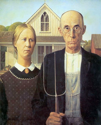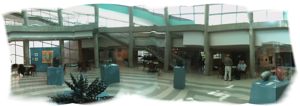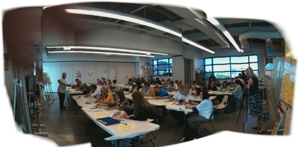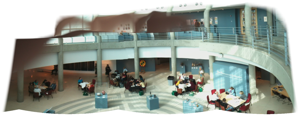I enjoyed working with Art teachers yesterday from across Iowa as well as a smattering of folks from Nebraska and South Dakota. I did the keynote described in my previous blog post and also a session on personal learning networks, which I will be repeating this morning. When my breakout was over, at 4:00, I was talking to a couple of teachers and taking my time disconnecting my computer, when a woman came up and very politely slide here MacBook Pro next to mine. It hadn’t occurred to me that the next presenter would be needing the projector and speakers. This was an Art teachers’ conference after all. Shame on me!
I disconnected and slid my computer and adapters over to the far side of the table so that I could pack them up as she continued to expertly set up her Mac and a colleague arranged various matted art works on other tables — the sort of thing I was actually expecting. The presenter was Ronda Sternhagen and her session was entitled Art and the Evolution of Mass Media.
I had scanned the program the night before selecting session that I might attend, and knew that there was one just after mine that interested me and that it had something to do with mass media — and although I was quite tired by then and had every intention abandoning that plan and heading back to my room to resting before a long walk around Sioux City, I chose to stay and rest in the back of that presentation room.
Sternhagen introduced her topic as the focus of her masters thesis, which she held up fairly close to her heart. It had been an ongoing theme in her family where she got her children in the habit of pointing out major works of art that appeared in the mass media, (magazines, TV commercials, etc.) and try to explain why those works had been selected.
 |
This approach to art instruction evolved into a course, which she described. The process that emerged had students, among other things, select major works of art and then photoshop themselves into the works. They also looked at how some art work was used to promote social issues, American Gothic being a favorite. This approach had such and impact on some of the other teachers and on the principal, that she will be team-teaching with one of the social studies teachers this year, finding ways to integrate works of art in to history and other social studies.
I was blown away by the presentation, which is saying a lot. I got a lot of take-away ideas from it. But I also walked out with two take-beyonds — which are different from take-aways, because they are ideas that I heard, that the presenter didn’t actually say (at lease I don’t remember here saying them).
Sternhagen, as she described these engaging activities and told stories about how the student responded, kept concluding that these techniques were great ways to help her teach art. What I heard was that her students were learning great ideas from history by working the art. When students take a specific work of art, and then photoshop it to illustrate some social (or scientific or mathematical) issue, then this production of media campaign becomes an avenue for exploring deeper curriculum issues.
The other take beyond was this idea of her team teaching with a social studies teacher. Social issues are easy. Might she team teach math, by integrating works of art into math instruction, or science, or literature, or literacy? Might she not become the school’s art integrationist? Would that be of benefit the entire school? My answer? Heck yea! She’d be a huge boost to the entire school. She might even be of more benefit than a tech integrationist.
But! Why not a literature integrationist? Or a literacy integrationis? ..or a math integrationist?
What I can’t shake is that this all seems to be pointing to a radically different arrangment of professional staff in our schools, and a different model for how teachers work together — a model that represents an antithesis of how teaching and learning is arranged in traditional schooling?
What do you think? And if you agree, what might that model look like?




Uh, isn’t this model of which you speak what occurs in many primary classrooms? Or in “middle schooling” situations? I think what’s more unique here is the level of collaboration between content-knowledge-experts (passionate and enthusiastic subject geeks!) moreso than “integration” 🙂
I also think a lot more of this (collaboration/integration) would occur if teachers had common planning time, especially in “non-compulsory” or “option subjects” such as Art, Languages, Music, etc. Unfortunately those “specialist teachers” often provide release time for the “regular teacher” in primary and middle-school contexts especially.
My district justed started a 2 year pilot program of problem based learning in 9th and 10th grade. The four core teachers work together to create lessons that involve all subjects. Last spring some of the students were able to go for the elective part of their day to an art institute that integrated all of the subjects.
I think “getting rid” of separate subjects in this way is a great model to integrate all subjects in a meaningful way.
My big regret is that I applied to be a part of this “school within a school” and did not get my dream job. I think it is a great model to improve schools.
Also I am a middle school technology teacher who is considered part of the Fine Arts department in my school. I have found these teachers to be more innovative because they teach their passion without textbooks or scripted curriculum. We are always being pushed to integrate reading, writing, and math into art lessons but the core classes could be improved by integrating the arts and the style of teaching into their lessons.
First of all, David…thank you for the “applause” of my presentation and work. It is an honor to be recognized by you! If you’d like a CD copy of the thesis, please contact me. You had already left the room when I handed those out. I will be presenting the same information in Cedar Falls, Iowa, on October 15, where Scott McLeod will be our keynote. Cool!
Penny…You are right that there is significantly more collaboration and connecting of the curriculum in the elementary. I used to be an elementary art teacher. It was a no-brainer that I connect what I was doing to the classroom, and was still able to teach the art concepts that I needed to teach. Unfortunately, that collaboration falls off a bit in middle school and high school. Obviously, it’s still a passion of mine to make learning (whatever the subject) more relevant so it “sticks.” The “special” teachers are much more than planning time, they are core to the curriculum.
My school, one of fairly low SES, would be a school that would benefit a great deal from a model such as this. My students are they exact type that do not thrive in the “old model” of education, yet possess so much creativity and potential that it becomes frustrating that we do not plan these cross-curricular types of lessons. In fact there is a heavy emphasis on the individual content, because these are the same types of students who do not perform well on the standardized tests.
It’s very difficult to (and I believe that this should be our main goal as educators) get people to understand that students today need so much richer and “rounder” instruction than the “old model” provides. Any suggestions about how to do this?
I’m an undergraduate student in Dr. Strange’s EDM course at the University of South Alabama. Throughout the semester we have been, and will be, learning about way to integrate technology into the classrooms. I believe it is very important to integrate technology as well as fine arts into our core curriculum. My high school counselor would constantly nag at me to take a variety of electives in order to become “well-rounded” for college. It was fantastic advise! However, students should not become “well-rounded” for college, they should become “well-rounded” for life. By integrating our learning, students will have a greater advantage because they will be able to visualize how these separate subject connect and work together. I’m not sure how to achieve my goal of integrating technology within schools, but I can start by being prepared to become a different version of the “old school” instructor. I will use the knowledge and experience I have to go above and beyond the expectations of teacher’s today. My only hope, it that there are enough motivated teachers already out there that we can force a change in the system.
I am not fond of the term “integration” as it brings to mind issues of power. Do we use the Arts to teach Math? Or will Math be used to teach the Arts? Do we value Art being taught for Arts sake?
However, I do love to hear stories of learning in context: cross-overs, cross-pollination, and crossing boundaries. Who can really understand the world through discrete strands of knowledge? Life just doesn’t work like that. I think meaningful learning is contextual, “just in time” and personal. Thank you for sharing the work being done by Ronda Sternhagen and the many thoughtful arts educators who are sharing their innovative methods for engaging students in their learning.
Thank you Sherron! I think that this is the question that I really had in mind as I struggled with this blog post. We fall back on terms that are common, within the profession, and there are good reasons to do that. But I feel the same way about the term integration.
I guess that my question is, in what sort of arrangement or structure ( or restructuring) of the school environment might we enable these sorts of cross-context exchanged between teachers? The real question is probably a whole lot bigger than that, but here’s where I’ll leave it for now…
@David Warlick,
i totally agree with what you said ” what sort of arrangement or structure ( or restructuring) of the school environment might we enable these sorts of cross-context exchanged between teachers?” that’s totally a fact
You are right as always:) Art as a discipline can be integrated into many subjects, and art itself shows an integration of knowledge to produce something useful and pleasant for one’s eyes and mind.
I do think it is a good for all subjects to be integrated into the classroom especially art. Many schools after primary school does not focus on art and the students loose interest in art completely. If art was used to help teach subjects like math and history the students would also gain more interest in this subjects. Myself as a students tends to learn better when I have something to relate a lesson to. If teachers uses art to help the students better understand a lesson I believe the students would leave class with more. I also agree that all subjects should be integrated into the classroom because it would be a good way to reinforce what the students are learning.
Your blog has given me really great ideas for my future classroom. Thank you for sharing your thoughts.
I enjoyed looking at the pics since it’s like a bubble eye effect and the 360Panorama seems like a good iPhone app.
Anyway, I think I’m not the only one who thinks that the word “integrationist” is such a heavy word. However, I did find your article quite interesting. Although I’m not such a huge fan of arts, this article enlightened me at least a little bit.
Thanks for sharing this David! These are great ideas and reflections that we will try at our school (River East Collegiate in Winnipeg, Canada). We have fabulous art and technology programs that could integrate so well making the curriculum real, maybe even come to life!
Thanks again!